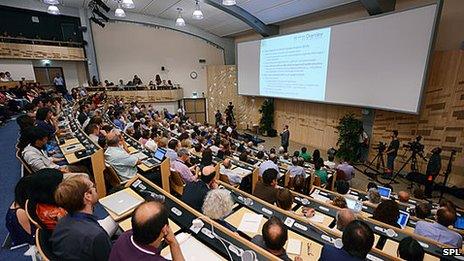Higgs boson results from LHC 'get even stronger'
- Published

The announcement on 4 July was greeted with enthusiasm around the world
The Higgs boson-like particle whose discovery was announced on 4 July looks significantly more certain to exist.
The particle has been the subject of a decades-long hunt as the last missing piece of physics' Standard Model, explaining why matter has mass.
Now one Higgs-hunting team at the Large Hadron Collider report a "5.9 sigma" levels of certainty it exists.
That equates to a one-in-550 million chance if the Higgs did not exist, the team would see these same results.
The formal threshold for claiming the discovery of a particle is a 5-sigma level - equivalent to a one-in-3.5 million chance.
That is the level that was claimed by the team behind Atlas, one of the LHC's Higgs-hunting experiments, during the 4 July announcement. The other, known as CMS, claimed results between 4.9 and 5 sigma.
The range reported by CMS at the time reflects the fact that there are a number of ways to look for the Higgs boson, none of which can observe it directly.
Accelerators like the LHC smash together particles at extraordinary energies in a bid to create a Higgs, which should exist only for a fleeting fraction of a second before decaying into other particles or flashes of light that can be caught and counted.
Now the Atlas team has submitted fuller analyses of these "decay channels", including one in which the Higgs ends up as two lighter particles known as W bosons.
As they report online in a paper submitted to Physics Letters B, external, their data now reach a significance of 5.9 sigma.
The CMS team reiterated its 5-sigma certainty in a paper submitted to the same journal, external, after incorporating more data from collisions at the heightened particle energies at which the LHC is running this year.
The findings only shore up a result that, as far as physicists were concerned, had already passed muster for declaring the existence of a new particle.
However, many questions remain as to whether the particle is indeed the long-sought Higgs boson; the announcement was carefully phrased to describe a "Higgs-like" particle.
More analyses will be needed to ensure it fits neatly into the Standard Model - the most complete theory we have for particles and forces - as it currently exists.
- Published4 July 2012
- Published4 July 2012
- Published4 July 2012